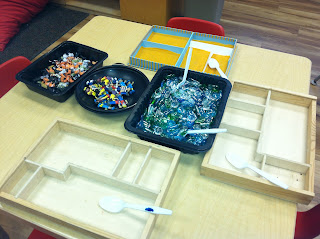Over the years, I’ve started thinking that the “Housekeeping
Area” (or “house corner” or “kitchen area”) isn’t the best use of space in my
preschool classroom. For starters, I’ve moved away from the idea of interest
areas in general. Materials are stored on accessible shelves, and children are
free to use them however and wherever in the room they like. The magnifying
glasses might be used for looking at fall leaves, or they might be used to stir
sand in the sensory table, or put in toy purses for a pretend shopping trip.
Children pretend to make and eat food in all areas of the room – why does there
need to be one area of the room focusing on that one pretend theme?
There’s also the fact that the historical context of “housekeeping” has
changed. Years ago, a classroom area fitted with kitchen appliances and toy
food was thought to be the most familiar setting for young children, who
presumably spent their days at home watching their mothers prepare meals, wash
dishes, clean house, and iron clothing. Today’s children might not actually see
much cooking going on, and might not be familiar with any appliance besides a
microwave.
My two-year-olds rarely play with the appliances. They make
soup by putting objects into a bowl, and don’t bother to put it on the pretend
stovetop. They bake cookies by arranging objects on a plate and putting them on
any surface. The only appliance they use with any regularity is the toy
microwave, and that might be for the attraction of pressing the buttons on the
front.
So, I’ve gradually gotten rid of many of the distinct “kitchen”
items. The stove/sink combos are still there, but with the doors taken off, so
that the materials are easier to see and to take out (without worrying about
doors shutting on fingers). I’ve added loose parts like wood circles and
pompoms to the plastic food, providing more opportunities for open ended,
creative, imaginative play.
The most recent change came when I changed classrooms this
year. Our new classroom is short of free wall space, so there isn’t a nook or “corner”
to put the housekeeping furniture in. The stove/sinks fit against a wall, but
there was no place to put a table in front without blocking the open space we
planned to use for block building, active play, and spreading materials out on
the rug.
Does a housekeeping area really need a table?
I thought about how the housekeeping table tended to be used
in my twos room. Children would take out all of the dishes and food, sometimes
entire baskets of materials, and fill the table. Following toddlers’ natural
desire to fill empty spaces, the activity focused on more filling the flat
surface of an empty table with any available objects, than on thematic pretend
play, or any activity involving planning or intentional selection of materials.
We have plenty of tables in the room, so even if a table
wasn’t placed as part of a housekeeping area, children could still choose to
use one for food and dishes. So we decided not to put a table right in front of
the stove/sink.
Instead of carrying kitchen materials over to the table, the
children moved their food and dishes onto the floor. The new room arrangement
provided a lot of open space in front of the shelves where the materials were
kept, and many children chose to play sitting right in front of the shelves,
even arranging the materials without taking them off. Being close to the block
area meant that children carried objects to the blocks, creating casual tables
on stacks of blocks. There was also much more intentional choice of materials.
Having the space to spread out the dishes led to children arranging them in
lines, across a large part of the rug, and carefully choosing pieces of food to
place in each dish. So far there hasn’t been the mad scramble to take out every
object and fill up the table top – in fact, so far, no one has even moved the
food to a table at all.




















